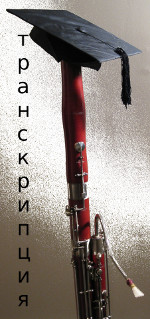Practicing Weissenborn Study #35, Part A
Weissenborn Opus 8/2, Study #35A for advanced bassoon students. Using
vibrato for phrasing. Ways to practice vibrato. Performance of study
#35. By Terry B. Ewell, Bassoon Digital Professor. Translated by Elena
Iakovleva. BDP#143A. www.2reed.net.
Изучение этюда Nº35, чясть А.
Вайсенборн опус 8/2, этюд №35 А для продвинутых студентов фаготистов.
Использование вибрато для фразировки. Способы занятия вибрато.
Исполнение этюда № 35.Терри Б. Юэлл, Цифровый Профессор Фагота.
Перевод, Елена Яковлева. BDP # 143А. www.2reed.net.
TUTORIAL Руководство
1. Welcome, this is Terry Ewell. Weissenborn study #35 is the case study for the rinforzando or “rf” markings. Weissenborn uses this mark throughout his studies to indicate a special type of emphasis in the quieter dynamics. Let’s examine the two comparable passages in the study that illustrate how the “rf” markings are employed.
1. Добро пожаловать, это Терри Юэлл. Этюд Вайссенборна № 35 - это этюд для изучения rinforzando или “rf”. Вайссенборн использует этот знак в своих этюдах, чтобы указать на особый тип акцента в более тихих нюансах. Давайте рассмотрим два сопоставимых отрывка в этюде, которые иллюстрируют, как используется “rf”.
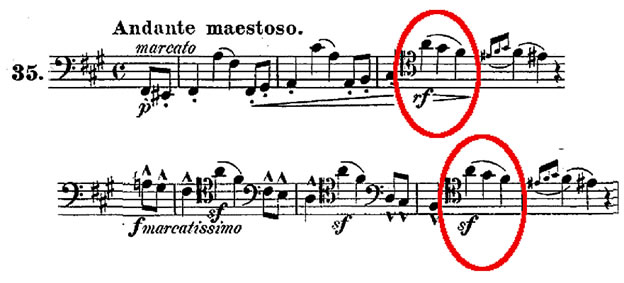
2. Notice the similarity between the musical passages. At the start of the study the “rf” is placed as the climax of a quieter dynamic. In lines 9 and 10 a “sf” is placed at the climax in the louder dynamic. Thus you can see that “rf” is a special kind of stress in the quieter dynamics much like “sf” is a special kind of stress in the louder dynamics. You might say that “rf,” rinforzando, is a quieter “sf,” sforzando. The “sf” can also be written as “sfz.”
2. Обратите внимание на сходство между этими музыкальными
пассажами.
В начале этюда “rf” ставится как кульминация более
тихого
нюанса. В 9 и 10й строчке, кульминацией в более громкой
динамике
оказывается «sf». Таким образом, понятно, что
“rf” - это особый вид ударения в более тихом
нюансе, очень
похожий на “sf” - который особый вид
ударения в более
громком нюансе. Можно сказать, что rinforzando, является более тихим
«sf», сфорцандо. «Sf» также
можно записать как
«sfz».
3. Many students make the mistake of thinking that staccato notes are always short. Staccato doesn’t mean short, it means separated. There should be some length to the opening staccato notes.
3. Многие студенты ошибаются, думая, что ноты которые стаккато, всегда короткие. Стаккато обозначает не коротко, а разделено. Вступительные ноты стаккато не должны быть слишком короткие.

4. In line 2 the portato notes, that is, staccato notes with slurs over them, are performed with even greater length.
4. В 2й строчке ноты portato, что есть ноты стаккато с лигами над ними, играются еще длиннее.

5. Do you remember the five articulation lengths we practiced in the earlier studies? The lengths of these notes here should be 4 or 5. If you have mastery over these lengths, you can even create phrase shaping with notes lengths. For instance, I will play this passage and increase the note lengths from 4 to 5 in order to provide musical motion to the G#3 on the downbeat of line 3, measure 1.
5. Вы помните пять видов длинны артикуляции, которыми мы занимались в предыдущих этюдах? Длинна вот этих нот должна быть номер 4 или 5. Если вы владеете этими длинами, вы можете даже создать рельеф фразы таким образом. Например, я сыграю этот отрывок и увеличу длину ноты с номера 4 до номера 5, чтобы обеспечить музыкальное движение в Соль # 3, на первой доли первого такта 3й строчки.
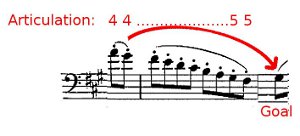
6. Don’t forget that accidentals carry through the measure. In line 4 measure 5 there are two D sharps. Line 5 measure 1 also has two D sharps.
6. Не забывайте, что случайные знаки длятся до конца такта. В 5м такте 4й строчке есть два Ре #. Первый такт 5й строчки, также имеет два Ре диеза.

7. A staccato mark refers to the length of the note not the start of the note. It doesn’t mean that the note is tongued just because there is a staccato mark over it. For instance, in line 9 the dots over the notes indicate a separation between it and the next note, however, they are slurred not tongued.
7. Знак Staccato относится к длине ноты, а не к началу ноты. Если над нотой стоит отметка стаккато, это не значит то что нота артикулирована языком. Например, в 9й строчке точки над нотами указывают на разделение между ними, однако они залигованные а не артикулированные.
2019 Correction:
I realize now that the statements above and below are wrong. At the time I was recalling some piano music I had studied, but it is clear here and in other contexts that the note with the dot under the slur is re-articulated, tongued.
For example, see this excerpt from Tchaikovsky's 2nd Symphony, the oboe solo in the second movement.
Исправление 2019 года:Теперь я понимаю, что эти утверждения неверны. В то время, я вспоминал партию для фортепианную, которую я было изучал, но здесь и в других контекстах ясно, что нота с точкой под лигой заново артикулированная, языком.
Например, посмотрите этот отрывок из 2-й симфонии Чайковского, соло гобоя во второй части.
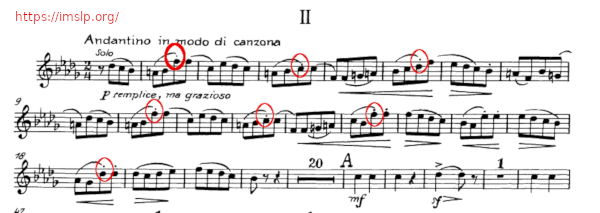
End 2019 Correction
8. F#3 starts with the tongue and then slurs to E#3. Two beats later B3 starts with the tongue then slurs down to A3.
8. Fа # 3 начинается с языком, а затем она залигованна в Ми # 3. Через две доли, Си3 начинается с языка, а затем она залигованна в Ля3.
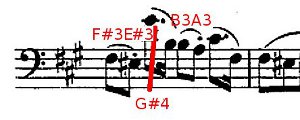
9. There are a few alternate fingerings I use in the study. In line 3 at the fermata I use the thumb G# key for a smoother transition from F#4. My standard F#4 uses the right hand little finger.
9. В этом этюде я использую несколько альтернативных аппликатур. В 3й строчке, на фермата я использую клапан большого пальца Соль # для более плавного перехода от Фа # 4. Мой стандартный Фа # 4 использует мизинец правой руки.
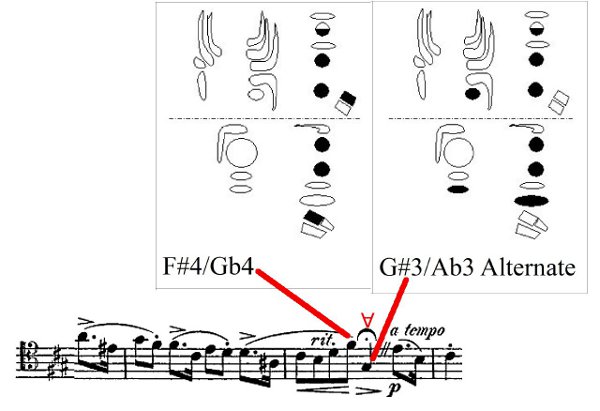
10. In line 7, measure 6 I use the trill fingering for the fast B3 to C#4 exchange.
10. В 6м такте 7й строке, я использую аппликатуру трели для быстрого обмена Си3 на До # 4.
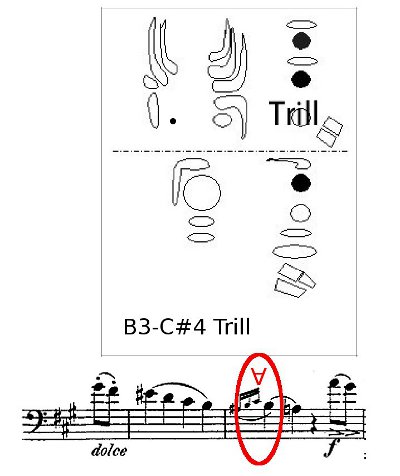
11. Similarly in line 10, measure 2 I also use the trill fingering for
movements between F#4 and G#4.
11. Аналогично, во 2м такте 10й строчке, я использую аппликатуру трели для движений между Фа # 4 и Соль # 4.
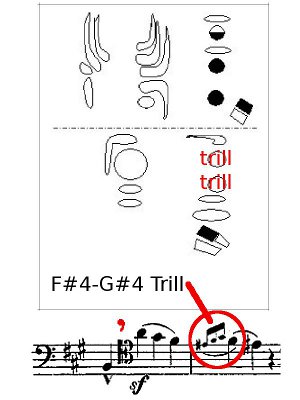
12. Weissenborn #37 will provide methods for practicing trills. Let me
provide some fingerings, however, for this study. For the trill in Line
4 in the first complete measure use this fingering.
12. Этюд Вайссенборна № 37 предоставит методы для занятия трелями. Позвольте мне, однако, предоставить некоторые аппликатуры для этого этюда. Для трели в 4й строчке в первом полном такте используйте вот эту аппликатуру.
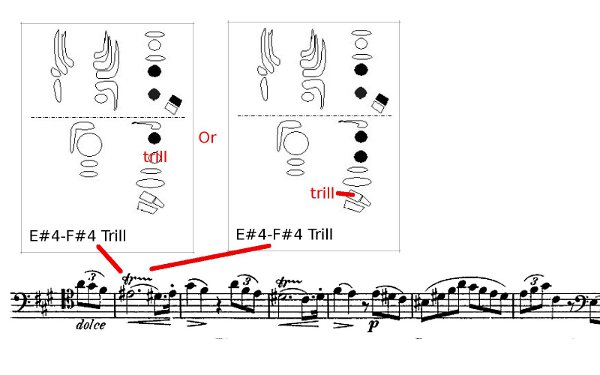
13. For the second trill in that line use this fingering.
13. Для второй трели в этой же строчке, используйте эту аппликатуру.
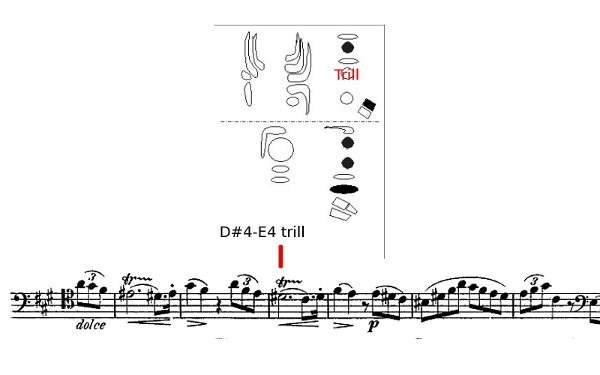
14. For the trill in line 9 you have two choices. I prefer the left hand C#4 but you can also use the C# trill key.
14. Для трели в 9й строчке у вас есть два варианта. Я предпочитаю До # 4 в левой руке, но вы также можете использовать клапан трели До #.
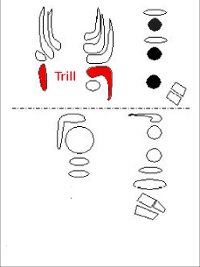
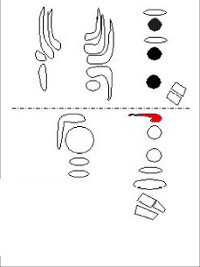
15. This is the first study with high C#, C#5. I use one of these three fingerings depending on my needs. The first fingering is the most common. It is not quite as full or loud as the last fingering, but is the easiest to use of the three and enunciates quite well. I almost always use both the D and C vent keys when I play this note.
15. Это первый этюд
с высоким До #, До
# 5. Я использую одну из этих трех аппликатур в зависимости от
потребности. Первая аппликатура является наиболее распространенной. С
ней получается не такой полный и громкий звук, как с последней
аппликатурой, но она самая легкая из трех. Я почти всегда использую
клапаны Ре и До, когда играю эту ноту.
16. The second fingering provides a good approach to D#5, when needed. The last fingering is especially good when a loud dynamic is needed. This fingering is my choice for the exalted C#5 in the Shostakovich 9th symphony, fourth movement.
16. Вторая аппликатура обеспечивает хороший подход к Ре # 5, когда это нужно. Последняя аппликатура особенно хороша, когда нужен громкий нюанс. Я выбираю эту аппликатуру для громкого До # 5 в четвертой части 9-й симфонии Шостаковича.
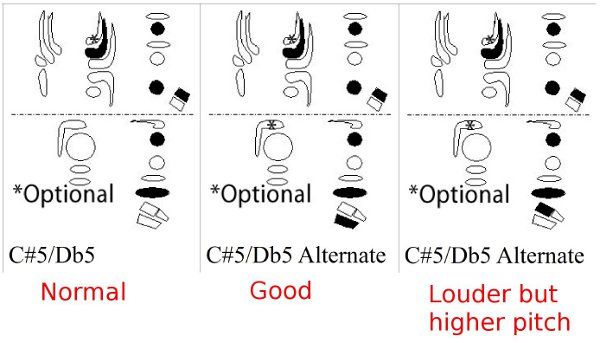
17. This is the first study in the collection that uses marcato
markings.
Marcato markings indicate even more forceful and intense accents than
regular accents. Weissenborn further provides the term marcatissimo
to emphasize the extreme accents in line 9.
17. Этот этюд, первый в сборнике, который использует marcato. Marcato указывает на еще более сильный и интенсивный акцент, чем обычно. Вайссенборн далее предоставляет термин marcatissimo, чтобы запросить крайне сильный акцент в 9й строчке.。
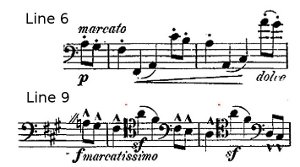
18. Notice the similarity between the quieter passage in line 6 and the louder passage in line 9. I have marked in breaths in lines 6-7 and 9-10. You don’t need to actually breathe each time, however, provide separation there and don’t breathe after the pair of slurred quarter-notes.
18. Обратите внимание на сходство между более тихим пассажем в 6й строчке и более громким пассажем в 9й строчке. Я отметил где брать дыхание в 6-7й строках и в 9-10й. Вам не нужно каждый раз дышать, однако, обеспечьте разделение и не дышите после пары залигованных четвертных нот.REFLECTION Размышление
Musical Expression vibrato
Вибрато музыкального выражения
19. In this reflection I will discuss vibrato. First I will identify
possible sources for the vibrato and then recommend the use of a
certain sound production component to produce vibrato.
19. В этом размышлении я буду обсуждать вибрато. Сначала я определю возможные источники вибрато, а затем порекомендую использовать определенный компонент для создания звука с вибрато.
20. Then I will apply “vibrato drives” or vibrato phrasing to some examples from the study and conclude with some exercises for vibrato mastery.
20. Затем я буду применять «шаблоны
вибрато» или фразы
на вибрато к некоторым примерам из этюда, и завершу некоторыми
упражнениями для овладения вибрато.
21. Some of the material provide here is drawn from the Second Chapter of my monograph titled “Wind Performer’s Guide to Increasing Endurance.”
21. Некоторый материал, представленный здесь, взят из второй
главы
моей монографии под названием «Учебник для духовиков для
повышения выносливости».
22. Bassoon performers have created vibrato from most of the five components for sound production: Component 1, the abdominal muscles; component 2, the throat area (larynx); from component 3, the back or pharangeal part of the tongue (this is the part of the tongue in the upper throat); and from component 5, the embouchure.
22. Фаготисты создали вибрато из большинства пяти компонентов для создания звука: компонент 1, мышцы живота; компонент 2, область горла (гортань); компонент 3 - задняя часть языка (это часть языка в верхней части глотки); и из компонента 5 - амбушюр.。
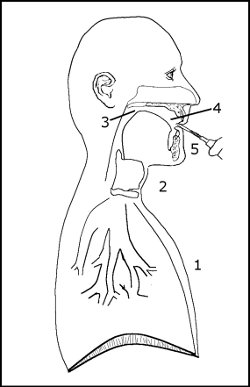
23. Component 1, the abdominal area, produces a slow and heavily pulsing vibrato. Many performers think that they produce vibrato from the abdominal area, but X-ray videos and small camera scopes have shown that the vibrato most bassoonists make originates in the throat area. These performers are probably feeling the back pressure in the abdominal area from the motions in the throat. When I produce a slow vibrato I have the sensation of vibrato in my abdominal area. As I increase the speed of the vibrato, however, the sensation appears to move up the wind column towards the throat.
23. Компонент номер 1, область живота, производит медленное и сильно пульсирующее вибрато. Многие исполнители думают, что они производят вибрато из области живота, но видео рентген показал, что вибрато большинства фаготистов создается в области горла. Эти исполнители, вероятно, чувствуют обратное давление в области живота от движения в горле. Когда я создаю медленное вибрато, у меня появляется ощущение вибрато в животе. Однако, когда я увеличиваю скорость вибрато, это ощущения, двигается вверх к горлу.
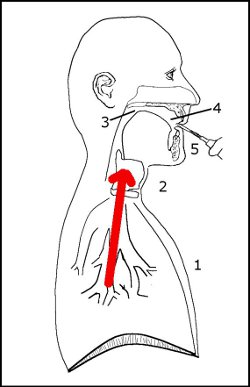
24. I do not recommend vibrato made from components 1 and 5. Component 1, the abdominal muscles should be employed for dynamic changes only. It also doesn’t produce the variety of speeds needed. When component 5, the embouchure or jaw, is used for vibrato it can vary the pitch too much. In addition, it is best to reserve the embouchure for tuning and shaping notes.
24. Я не рекомендую извлекать вибрато компонентами номер 1 и
5.
Компонент 1, мышцы живота следует использовать только для изменений
нюанса. Кроме того, с ним не возможно достичь разнообразие скоростей.
Когда компонент номер 5, амбушюр или челюсть, используется для вибрато,
он может слишком сильно изменить высоту ноты. Кроме того, лучше всего
зарезервировать амбушюр для настройки и формирования рельефа нот.
25. I recommend using the throat area, component 2, since this
area is not employed for any other sound production needs. Component 2
can then operate independently from the other components. Some
performers also sympathetically move part of the tongue in the throat
when they create vibrato.
Many vibrato studies of woodwind instrument performers indicate that
although the mechanisms for vibrato are contained in the throat area,
the muscle groups used for vibrato can vary widely. There are many
moving parts in our throat areas. Some parts are used by certain
performers and other muscles and structures are employed by other
people for vibrato.
25. Я рекомендую использовать область горла, компонент номер 2, так как эта область больше не для чего не используется в извлечение звука. Компонент 2 может по этому работать независимо от других компонентов. Некоторые солисты также перемещают заднюю часть языка, когда они создают вибрато.Многие исследование вибрато духовиков показывают, что, хотя механизмы вибрато содержатся в области горла, группы мышц, используемые для вибрато, могут сильно различатся. В горле есть много движущихся частей. Некоторые исполнители пользуются одними, а некоторые пользуются другими мышцами и структурами для своего вибрато.
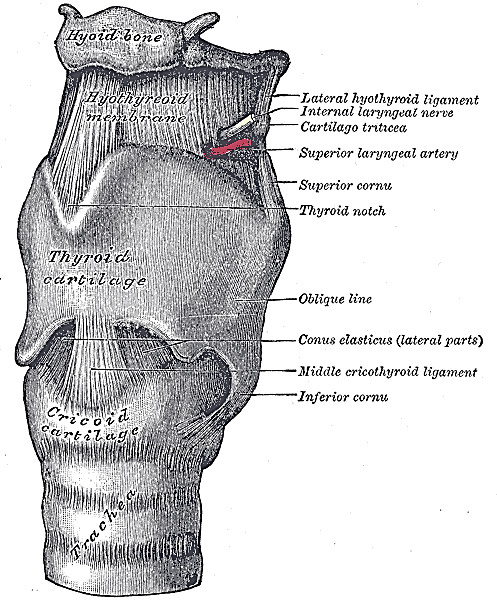
Larynx Illustration from Henry Gray, Anatomy of the Human Body, 1918, accessed from www.bartleby.com, 16 Aug 2006.
Иллюстрация гортани от Генри Грея, «Анатомия
человеческого
тела», 1918 г., по адресу www.bartleby.com, 16 августа 2006 г.
26. I provide references at the end of the video (see the transcript for Weissenborn 35B) if you wish to learn more about vibrato.
26. В конце видео я предоставляю ссылки (см. Стенограмму
Вайссенборна 35B), если вам хочется узнать побольше о вибрато.
